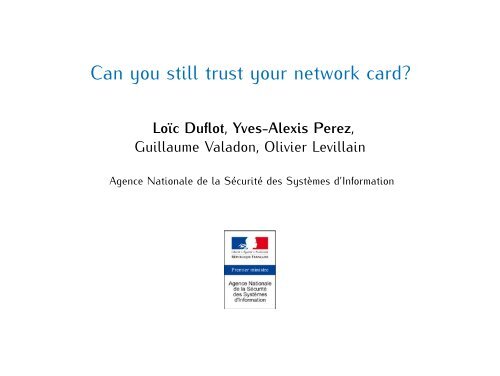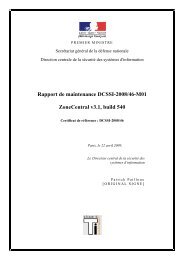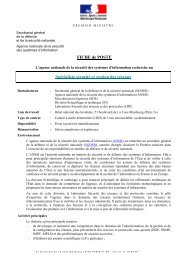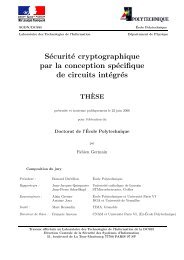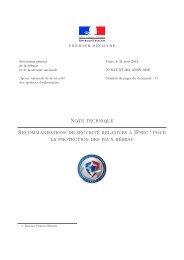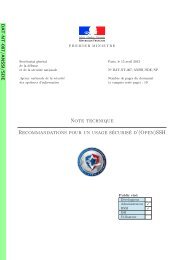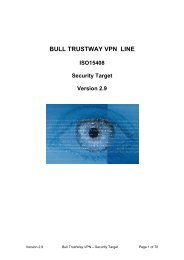Can you still trust your network card? - Agence nationale de la ...
Can you still trust your network card? - Agence nationale de la ...
Can you still trust your network card? - Agence nationale de la ...
You also want an ePaper? Increase the reach of your titles
YUMPU automatically turns print PDFs into web optimized ePapers that Google loves.
<strong>Can</strong> <strong>you</strong> <strong>still</strong> <strong>trust</strong> <strong>you</strong>r <strong>network</strong> <strong>card</strong>?<br />
Loïc Duflot, Yves-Alexis Perez,<br />
Guil<strong>la</strong>ume Va<strong>la</strong>don, Olivier Levil<strong>la</strong>in<br />
<strong>Agence</strong> Nationale <strong>de</strong> <strong>la</strong> Sécurité <strong>de</strong>s Systèmes d’Information
Mo<strong>de</strong>rn <strong>network</strong> <strong>card</strong>s<br />
They do not only connect the host to the <strong>network</strong>.<br />
◮ Hardware architectures are complex:<br />
◮ several processors,<br />
◮ different kind of memories,<br />
◮ multiple <strong>network</strong> interfaces;<br />
◮ Embed<strong>de</strong>d softwares (firmwares) do more than <strong>you</strong> think:<br />
◮ remote administration: ASF, IPMI, AMT, etc,<br />
◮ TCP segmentation offloading,<br />
◮ radio with temporal constraints: GSM, 802.11, etc.<br />
SGDSN/ANSSI – http://www.ssi.gouv.fr/<strong>trust</strong><strong>network</strong><strong>card</strong> 2/51
Impacts on security<br />
If an attacker can execute arbitrary co<strong>de</strong> on the <strong>card</strong>, she can do<br />
virtually anything:<br />
◮ stop processing packets;<br />
◮ drop some packets;<br />
◮ ARP/DNS cache poisoning;<br />
◮ implement SSLstrip-like attacks;<br />
◮ attacks hosts on the LAN;<br />
◮ rep<strong>la</strong>ce the firmware;<br />
◮ attack the host (read/write access to the main memory).<br />
A ”must read” on this topic:<br />
Arrigo Triulzi, PacSec08, ”Project Maux Mk.II”<br />
SGDSN/ANSSI – http://www.ssi.gouv.fr/<strong>trust</strong><strong>network</strong><strong>card</strong> 3/51
What will be <strong>de</strong>scribed today<br />
We will present:<br />
◮ architectures of mo<strong>de</strong>rn <strong>network</strong> <strong>card</strong>s;<br />
◮ remote administration protocols used in these <strong>card</strong>s;<br />
◮ an actual vulnerability that we discovered;<br />
◮ tools <strong>de</strong>veloped to <strong>de</strong>bug a Broadcom NetXtreme <strong>card</strong>;<br />
◮ exploitation proof of concept and <strong>de</strong>mo;<br />
◮ mitigations and workarounds to this attack.<br />
SGDSN/ANSSI – http://www.ssi.gouv.fr/<strong>trust</strong><strong>network</strong><strong>card</strong> 4/51
What won’t be <strong>de</strong>scribed today<br />
This is not about:<br />
◮ driver bugs;<br />
◮ OS vulnerabilities.<br />
And please note that:<br />
◮ we won’t provi<strong>de</strong> the <strong>network</strong> packets and the tools used in<br />
the <strong>de</strong>mo;<br />
◮ we worked with the vendors and they issued a patch for the<br />
vulnerability.<br />
◮ CVE-2010-0104: HP Small Form Factor or Microtower PC<br />
with Broadcom Integrated NIC Firmware, Remote Execution of<br />
Arbitrary Co<strong>de</strong><br />
http://www.ssi.gouv.fr/<strong>trust</strong><strong>network</strong><strong>card</strong><br />
SGDSN/ANSSI – http://www.ssi.gouv.fr/<strong>trust</strong><strong>network</strong><strong>card</strong> 5/51
Network interface controller Architecture<br />
Internal architecture of a <strong>network</strong> <strong>card</strong><br />
◮ PHY: send and receive signals on the wire;<br />
◮ DMA-engine: exchange packets with the host;<br />
◮ negotiation and link control (speed, duplex), etc.<br />
SGDSN/ANSSI – http://www.ssi.gouv.fr/<strong>trust</strong><strong>network</strong><strong>card</strong> 6/51
Network interface controller The NetXtreme architecture<br />
Internal architecture of NetXtreme <strong>network</strong> <strong>card</strong><br />
◮ performs various operations on packets;<br />
◮ offloads work from host;<br />
◮ needs hardware and software to do that;<br />
◮ runs as an intercepting proxy.<br />
SGDSN/ANSSI – http://www.ssi.gouv.fr/<strong>trust</strong><strong>network</strong><strong>card</strong> 7/51
Network interface controller The NetXtreme architecture<br />
RX RISC<br />
An on-chip RISC processor is provi<strong>de</strong>d for running value-ad<strong>de</strong>d firmware<br />
that can be used for custom frame processing. The on-chip RISC operates<br />
in<strong>de</strong>pen<strong>de</strong>ntly of all the architectural blocks; essentially, RISC is avai<strong>la</strong>ble<br />
for the auxiliary processing of data streams.<br />
◮ a MIPS CPU on the <strong>card</strong>;<br />
◮ it has access to major components:<br />
◮ shared memory,<br />
◮ incoming and outgoing packets,<br />
◮ PCI Configuration Space,<br />
◮ SMBus;<br />
◮ it executes a firmware.<br />
SGDSN/ANSSI – http://www.ssi.gouv.fr/<strong>trust</strong><strong>network</strong><strong>card</strong> 8/51
Network interface controller The NetXtreme architecture<br />
The firmware in the NetXtreme<br />
Different firmwares:<br />
◮ ASF (Alert Standard Format protocol);<br />
◮ TSO (TCP Segmentation Offloading).<br />
The firmware is:<br />
◮ loa<strong>de</strong>d from an EEPROM;<br />
◮ or by the driver from the filesystem:<br />
◮ Linux driver only has TSO,<br />
◮ Windows drivers rarely have a firmware,<br />
◮ the firmware seems protected;<br />
◮ loa<strong>de</strong>d to memory (SRAM) during execution.<br />
SGDSN/ANSSI – http://www.ssi.gouv.fr/<strong>trust</strong><strong>network</strong><strong>card</strong> 9/51
Network interface controller The NetXtreme architecture<br />
Internal memory<br />
◮ the <strong>card</strong> internal memory is mapped to the host one;<br />
◮ internal memory can be accessed through a 32kb window;<br />
◮ this window can be moved to read the whole internal memory<br />
space from the host.<br />
SGDSN/ANSSI – http://www.ssi.gouv.fr/<strong>trust</strong><strong>network</strong><strong>card</strong> 10/51
Remote administration protocols ASF<br />
Alert Standard Format (ASF) 1.0 1/3<br />
ASF<br />
◮ transmits alerts/events using the <strong>network</strong>:<br />
◮ hard disks failures, BIOS errors, ...<br />
◮ heartbeats (”machine is up”);<br />
◮ must operate if everything else fails (<strong>de</strong>ad hard disks, OS).<br />
The <strong>network</strong> <strong>card</strong> receives events from others <strong>de</strong>vices using the<br />
SMBus (System Management Bus).<br />
RMCP<br />
◮ ASF uses a protocol called Remote Management and Control<br />
Protocol;<br />
◮ RMCP can query system state;<br />
◮ RMCP allows to remotely start, stop or reboot computers.<br />
SGDSN/ANSSI – http://www.ssi.gouv.fr/<strong>trust</strong><strong>network</strong><strong>card</strong> 11/51
Remote administration protocols ASF<br />
Alert Standard Format (ASF) 1.0 (2/3)<br />
◮ firmware parameters must be configured: IP address, netmask,<br />
heartbeats frequency,<br />
◮ a tool is provi<strong>de</strong>d by <strong>network</strong> <strong>card</strong>s vendors;<br />
◮ a specific ACPI table is used by ASF;<br />
◮ ASF can be <strong>de</strong>activated from the BIOS on some hardware;<br />
◮ at least one boot on an ACPI-enabled OS is mandatory.<br />
SGDSN/ANSSI – http://www.ssi.gouv.fr/<strong>trust</strong><strong>network</strong><strong>card</strong> 12/51
Remote administration protocols ASF<br />
ASF 1.0 (3/3)<br />
Security<br />
◮ no security interfaces;<br />
◮ vendors are discouraged to implement their own, proprietary<br />
security interface;<br />
◮ security issues should be addressed at <strong>network</strong> infrastructure<br />
level.<br />
SGDSN/ANSSI – http://www.ssi.gouv.fr/<strong>trust</strong><strong>network</strong><strong>card</strong> 13/51
Remote administration protocols ASF<br />
ASF configuration<br />
◮ IP addresses;<br />
◮ RMCP;<br />
◮ permissions;<br />
SGDSN/ANSSI – http://www.ssi.gouv.fr/<strong>trust</strong><strong>network</strong><strong>card</strong> 14/51
Remote administration protocols ASF<br />
Alert Standard Format (ASF) 2.0<br />
ASF 2.0 adds a new protocol: RSP<br />
◮ RMCP security-extensions protocol;<br />
◮ adds authentication and integrity protection;<br />
◮ no encryption.<br />
This presentation focuses on ASF 2.0.<br />
SGDSN/ANSSI – http://www.ssi.gouv.fr/<strong>trust</strong><strong>network</strong><strong>card</strong> 15/51
Remote administration protocols RMCP<br />
RMCP in ASF 2.0<br />
◮ messages are sent over UDP;<br />
◮ traffic must be either sent on:<br />
◮ the legacy port 623/udp: no authentication, no integrity,<br />
◮ the secure port 664/udp: RMCP messages are carried insi<strong>de</strong><br />
RMCP Security-Extensions Protocol (RSP);<br />
◮ the <strong>network</strong> <strong>card</strong> grabs traffic on these ports, analyzes RMCP<br />
packets, and replies to queries.<br />
The <strong>network</strong> <strong>card</strong> must implement the following stack:<br />
IP/UDP/RSP/RMCP.<br />
SGDSN/ANSSI – http://www.ssi.gouv.fr/<strong>trust</strong><strong>network</strong><strong>card</strong> 16/51
Remote administration protocols RMCP<br />
Protocols stacks<br />
SGDSN/ANSSI – http://www.ssi.gouv.fr/<strong>trust</strong><strong>network</strong><strong>card</strong> 17/51
Remote administration protocols RMCP<br />
RMCP Security-Extensions Protocol (RSP)<br />
◮ RSP adds mutual authentication of the remote console and the<br />
client;<br />
◮ the console is the management <strong>de</strong>vice used by the administrator,<br />
◮ the client is the remote workstation;<br />
◮ messages are authenticated using pre-shared HMAC-SHA1 keys;<br />
◮ in or<strong>de</strong>r to send a message on the secure port, the console<br />
must:<br />
◮ open a session,<br />
◮ negociate a session key (three messages are exchanged),<br />
◮ send the RMCP message protected with the sessions key over<br />
RSP.<br />
SGDSN/ANSSI – http://www.ssi.gouv.fr/<strong>trust</strong><strong>network</strong><strong>card</strong> 18/51
Remote administration protocols RMCP<br />
RSP session protocol (RSSP)<br />
Console Client<br />
OpenSessionRequest<br />
OpenSessionResponse<br />
RAKP1<br />
RAKP2<br />
RAKP3<br />
SGDSN/ANSSI – http://www.ssi.gouv.fr/<strong>trust</strong><strong>network</strong><strong>card</strong> 19/51
Remote administration protocols Summary<br />
The RMCP messages<br />
◮ Presence Ping / Presence Pong;<br />
◮ CapabilitiesRequest / CapabilitiesResponse;<br />
<strong>de</strong>scribe which operations are possible on the legacy and the<br />
secure ports;<br />
◮ System State Request / System State Response;<br />
ask system about status, <strong>la</strong>st boot medium etc.<br />
◮ startup request (<strong>de</strong>vice can be specified: PXE, hard disk, CD-ROM);<br />
◮ reboot request;<br />
◮ stop request.<br />
SGDSN/ANSSI – http://www.ssi.gouv.fr/<strong>trust</strong><strong>network</strong><strong>card</strong> 20/51
Remote administration protocols Summary<br />
Status of RMCP support<br />
Some hardware with ASF support that we tested:<br />
◮ HP Compaq dc7600<br />
◮ on the secure port, start/reboot/stop messages are processed;<br />
◮ DELL Latitu<strong>de</strong> D530 and Precision T5400<br />
◮ CapabilitiesRequest messages are processed,<br />
◮ CapabilitiesReply messages indicate that no remote administration<br />
function is supported.<br />
Remarks<br />
◮ no vendor enabled remote administration on the legacy port;<br />
◮ why do some vendors disable administration functions<br />
but <strong>still</strong> implement RMCP and SMBus functions?<br />
SGDSN/ANSSI – http://www.ssi.gouv.fr/<strong>trust</strong><strong>network</strong><strong>card</strong> 21/51
Remote administration protocols Summary<br />
Card’s behavior when using ASF<br />
When it receives a packet, the <strong>card</strong><br />
◮ intercepts the packet;<br />
◮ before transmitting it to the OS;<br />
◮ checks if it is a RMCP packet;<br />
◮ process it:<br />
◮ open/close session,<br />
◮ send system state informations,<br />
◮ perform system administration tasks,<br />
◮ the packet is NOT transmitted to the host.<br />
SGDSN/ANSSI – http://www.ssi.gouv.fr/<strong>trust</strong><strong>network</strong><strong>card</strong> 22/51
Protocol analysis Protocol security<br />
Protocol security (1/2)<br />
Potential issues<br />
◮ protocol uses 160bit pre-shared keys, which means all clients<br />
might have the same keys;<br />
◮ messages are integrity protected but the integrity pattern does<br />
not inclu<strong>de</strong> message ID;<br />
◮ in or<strong>de</strong>r to act as the console, an attacker just has to send a<br />
RAKP3 with a valid HMAC.<br />
Exploitation<br />
◮ is it possible to forge the HMAC?<br />
◮ can the client act as a integrity oracle?<br />
SGDSN/ANSSI – http://www.ssi.gouv.fr/<strong>trust</strong><strong>network</strong><strong>card</strong> 23/51
Protocol analysis Protocol security<br />
Protocol security (2/2)<br />
Not so easy<br />
◮ only two concurrent sessions on the implementation we tested;<br />
◮ not all fields are un<strong>de</strong>r the attacker’s control;<br />
◮ fields size problems.<br />
HMAC/RAKP2<br />
HMAC/RAKP3<br />
0 15 31 47<br />
SIDm SIDc<br />
Rc<br />
Rc<br />
SIDm Rolem<br />
ULength m<br />
UNamem<br />
Rm Rolem<br />
ULength m<br />
UNamem<br />
SGDSN/ANSSI – http://www.ssi.gouv.fr/<strong>trust</strong><strong>network</strong><strong>card</strong> 24/51
Protocol analysis Implementation problems<br />
Implementation problems (1/2)<br />
Interesting fields un<strong>de</strong>r the attacker’s control<br />
◮ management console username (RAKP1 message);<br />
◮ management console session ID (Open Session Request).<br />
Trying to p<strong>la</strong>y with them, messing with<br />
◮ size;<br />
◮ content.<br />
SGDSN/ANSSI – http://www.ssi.gouv.fr/<strong>trust</strong><strong>network</strong><strong>card</strong> 25/51
Protocol analysis Implementation problems<br />
Implementation problems (2/2)<br />
Username<br />
◮ specifications limit the size to 16 chars, without NULL;<br />
◮ the username size is co<strong>de</strong>d using a 1 byte field.<br />
What if we don’t p<strong>la</strong>y nice?<br />
◮ ”the <strong>card</strong> crashes”;<br />
◮ the host can only send Ethernet frames but not receive them.<br />
What did exactly happen?<br />
SGDSN/ANSSI – http://www.ssi.gouv.fr/<strong>trust</strong><strong>network</strong><strong>card</strong> 26/51
The vulnerability Instrumenting the <strong>card</strong><br />
Proof of concept<br />
◮ Is the vulnerability serious?<br />
◮ What are the direct and indirect consequences?<br />
◮ How can we build a proof of concept?<br />
Speaker switch<br />
SGDSN/ANSSI – http://www.ssi.gouv.fr/<strong>trust</strong><strong>network</strong><strong>card</strong> 27/51
The vulnerability Instrumenting the <strong>card</strong><br />
Instrumenting the <strong>card</strong> (1/2)<br />
How did we find out what happened?<br />
◮ what is really crashing?<br />
◮ how is it crashing?<br />
Using the NetXtreme specifications<br />
◮ public specs avai<strong>la</strong>ble for open-source <strong>de</strong>velopers;<br />
◮ <strong>de</strong>scribe the internal <strong>card</strong> behavior;<br />
◮ give informations about RX RISC components.<br />
SGDSN/ANSSI – http://www.ssi.gouv.fr/<strong>trust</strong><strong>network</strong><strong>card</strong> 28/51
The vulnerability Instrumenting the <strong>card</strong><br />
Instrumenting the <strong>card</strong> (2/2)<br />
How to <strong>de</strong>bug the RX RISC? We need to:<br />
◮ follow the execution flow;<br />
◮ know registers contents;<br />
◮ know why the CPU stops;<br />
◮ trace data.<br />
We need a <strong>network</strong> <strong>card</strong> <strong>de</strong>bugger.<br />
SGDSN/ANSSI – http://www.ssi.gouv.fr/<strong>trust</strong><strong>network</strong><strong>card</strong> 29/51
The vulnerability Instrumenting the <strong>card</strong><br />
What information can we retrieve from the <strong>card</strong>?<br />
Specifications and experiments say we have access to:<br />
◮ RX RISC mo<strong>de</strong> register;<br />
◮ RX RISC state register;<br />
◮ RX RISC program counter;<br />
◮ RX RISC hardware breakpoint register;<br />
◮ some general registers.<br />
We can use this knowledge to build that <strong>de</strong>bugger.<br />
SGDSN/ANSSI – http://www.ssi.gouv.fr/<strong>trust</strong><strong>network</strong><strong>card</strong> 30/51
The vulnerability Instrumenting the <strong>card</strong><br />
Our homema<strong>de</strong> <strong>de</strong>bugger:<br />
◮ uses information from mapped registers;<br />
◮ runs in step-by-step mo<strong>de</strong>;<br />
◮ can perform register/memory tracking;<br />
◮ can break on register/memory access;<br />
◮ can do some pattern matching.<br />
SGDSN/ANSSI – http://www.ssi.gouv.fr/<strong>trust</strong><strong>network</strong><strong>card</strong> 31/51
The vulnerability Instrumenting the <strong>card</strong><br />
Help<br />
What should I do next (h for help)? h<br />
Usage:<br />
’a’ -> Advance n steps ’T’ -> Track register<br />
’s’ -> Advance 1 step ’L’ -> Track memory address<br />
’t’ -> Trace ’Z’ -> Track specific memory zone access<br />
’c’ -> Continue ’I’ -> Track pattern in memory<br />
’C’ -> Continue (step-by-step ’P’ -> Track pattern<br />
’g’ -> Break on instruction ’x’ -> Clear tracking<br />
’R’ -> Break on pattern in register ’f’ -> Find pattern in internal memory<br />
’S’ -> Break on pattern in stack ’F’ -> Find pattern in external memory<br />
’H’ -> Break on pattern in internal memory ’A’ -> Find all patterns in external memory<br />
’M’ -> Break on pattern in external memory ’d’ -> Disp<strong>la</strong>y memory address<br />
’n’ -> Break on next pattern in stack ’D’ -> Disp<strong>la</strong>y memory area<br />
’l’ -> Break on specific memory access ’w’ -> Write a word to memory address<br />
’m’ -> Break on any memory access ’r’ -> Reset CPU<br />
’j’ -> Break on register write ’q’ -> Quit<br />
’i’ -> Break on instruction<br />
SGDSN/ANSSI – http://www.ssi.gouv.fr/<strong>trust</strong><strong>network</strong><strong>card</strong> 32/51
The vulnerability Instrumenting the <strong>card</strong><br />
CPU<br />
******** Instruction<br />
Instruction = 3c020001 LUI r2 = 00010000<br />
Last memory access = 00000000<br />
******** CPU Status Registers ******<br />
RXPC = 00011078 RXHWBRK = 0000001d<br />
RXMODE = 00009db0 RXSTATE = 80001400<br />
SGDSN/ANSSI – http://www.ssi.gouv.fr/<strong>trust</strong><strong>network</strong><strong>card</strong> 33/51
The vulnerability Instrumenting the <strong>card</strong><br />
General registers<br />
******** CPU Registers **************************************<br />
$0 = 00000000 $1 = 00010000 $2 = 00000000 $3 = 40000000<br />
$4 = 0001b4b8 $5 = 0001b8e6 $6 = 00000000 $7 = 0001bfc4<br />
$8 = 00000040 $9 = 00000050 $10 = 0001b8bc $11 = 0001bfc0<br />
$12 = 80000000 $13 = 00000001 $14 = 00000000 $15 = ffffffbf<br />
$16 = a4020000 $17 = aaaaaaaa $18 = 00000000 $19 = 0001af48<br />
$20 = 0000ad60 $21 = 018004f1 $22 = 000000fc $23 = 00010000<br />
$24 = ffffffff $25 = 80000000 $26 = 00000b50 $27 = 00011104<br />
$28 = c0000000 $29 = 0001bfd8 $30 = 0001c000 $31 = 000111f8<br />
SGDSN/ANSSI – http://www.ssi.gouv.fr/<strong>trust</strong><strong>network</strong><strong>card</strong> 34/51
The vulnerability Instrumenting the <strong>card</strong><br />
Stack<br />
******** Stack *****************************<br />
Stack pointer: 0001bfd8 (max) stack size: 10<br />
Stack bottom: 0001c000<br />
********************************************<br />
0001bffc:73ffffff 0001bfe8:00010e00<br />
0001bff8:00010044 0001bfe4:0001a918<br />
0001bff4:0001a000 0001bfe0:0000ad60<br />
0001bff0:0000ad64 0001bfdc:0001a000<br />
0001bfec:0001a80c 0001bfd8:00010b3c<br />
SGDSN/ANSSI – http://www.ssi.gouv.fr/<strong>trust</strong><strong>network</strong><strong>card</strong> 35/51
The vulnerability Crash analysis<br />
Why does the <strong>card</strong> crash?<br />
RX RISC state register provi<strong>de</strong>s useful information:<br />
1. bad memory alignment<br />
2. invalid instruction fetch (jump to invalid location);<br />
3. invalid data access (load/store in invalid location);<br />
4. invalid instruction;<br />
Points 2 and 4 can mean direct flow execution redirection.<br />
Points 1 and 3 can mean indirect flow execution redirection (try to<br />
overwrite a return address in the stack).<br />
SGDSN/ANSSI – http://www.ssi.gouv.fr/<strong>trust</strong><strong>network</strong><strong>card</strong> 36/51
The vulnerability Crash analysis<br />
Changing the execution flow<br />
When the RX RISC CPU is crashing, an attacker needs to:<br />
◮ find the source of the data;<br />
◮ tune it to fit her needs.<br />
Trials and errors<br />
We managed to:<br />
◮ make the username field overflow;<br />
◮ overwrite a return address in the stack with an address un<strong>de</strong>r<br />
our control.<br />
SGDSN/ANSSI – http://www.ssi.gouv.fr/<strong>trust</strong><strong>network</strong><strong>card</strong> 37/51
The vulnerability Crash analysis<br />
Proof of concept co<strong>de</strong> injection (1/2)<br />
On this particu<strong>la</strong>r NIC and firmware version, an attacker is able to<br />
perform arbitrary co<strong>de</strong> execution:<br />
Initial jump<br />
◮ an attacker can overwrite a return address in the stack;<br />
◮ she can find a stable (for a firmware version) memory address<br />
for username;<br />
◮ she can put exploit co<strong>de</strong> in username and jump there.<br />
Stage 1<br />
◮ username is 255 chars (minus padding), not much instructions;<br />
◮ but the attacker has access to <strong>network</strong> buffers;<br />
◮ she can put co<strong>de</strong> in a previously sent packet and jump there.<br />
SGDSN/ANSSI – http://www.ssi.gouv.fr/<strong>trust</strong><strong>network</strong><strong>card</strong> 38/51
The vulnerability Crash analysis<br />
Exploit and stage 1<br />
0x1c000<br />
0x1befc 0x14940<br />
0x1bfc4<br />
Stack<br />
nop<br />
nop<br />
nop<br />
nop<br />
addiu $1,$1, 1<br />
Username<br />
Heap<br />
SGDSN/ANSSI – http://www.ssi.gouv.fr/<strong>trust</strong><strong>network</strong><strong>card</strong> 39/51
The vulnerability Crash analysis<br />
Proof of concept co<strong>de</strong> injection (2/2)<br />
stage 2<br />
◮ size virtually unlimited;<br />
◮ sent like a normal packet before the exploit;<br />
◮ prepen<strong>de</strong>d by a magic number so stage 1 can find it.<br />
Now the attacker can:<br />
◮ run arbitrary co<strong>de</strong> on the RX RISC;<br />
◮ provi<strong>de</strong> new co<strong>de</strong> using simple packets;<br />
◮ rewrite the firmware if nee<strong>de</strong>d;<br />
◮ ...<br />
SGDSN/ANSSI – http://www.ssi.gouv.fr/<strong>trust</strong><strong>network</strong><strong>card</strong> 40/51
The vulnerability Crash analysis<br />
Stage 2<br />
nop<br />
nop<br />
nop<br />
nop<br />
addiu $1,$1, 1 look<br />
for<br />
magic<br />
Username<br />
Heap<br />
number<br />
address<br />
and<br />
jump<br />
to<br />
it<br />
magic<br />
number<br />
IP Packet (stage 2)<br />
Scratchpad memory<br />
SGDSN/ANSSI – http://www.ssi.gouv.fr/<strong>trust</strong><strong>network</strong><strong>card</strong> 41/51
Real impact What can be done in the <strong>network</strong> <strong>card</strong>?<br />
Man in the middle<br />
Every packet ends up in the <strong>card</strong> memory:<br />
◮ received packets before reaching the host;<br />
◮ sent packets before being emitted on the wire.<br />
P<strong>la</strong>y<br />
◮ reroute DNS traffic;<br />
◮ reroute all traffic;<br />
◮ modify TLS negotiations;<br />
◮ perform any conceivable MITM stealthily.<br />
SGDSN/ANSSI – http://www.ssi.gouv.fr/<strong>trust</strong><strong>network</strong><strong>card</strong> 42/51
Real impact What can be done in the <strong>network</strong> <strong>card</strong>?<br />
Remote management<br />
Remember DELL disabled remote management?<br />
◮ but the controller is connected to the SMBus;<br />
◮ ASF! <strong>de</strong>scription table is present with the remote control functions;<br />
◮ the exploit send messages to the SMBus;<br />
◮ therefore it can perform power-up, power-down, power-cycle, ...<br />
It can be reimplemented!<br />
SGDSN/ANSSI – http://www.ssi.gouv.fr/<strong>trust</strong><strong>network</strong><strong>card</strong> 43/51
Real impact What can be done in the <strong>network</strong> <strong>card</strong>?<br />
Take-over the host<br />
The <strong>network</strong> <strong>card</strong>:<br />
◮ is on the PCI/PCI-Express bus;<br />
◮ can read/write to PCI configuration space;<br />
◮ has Direct Memory Access (DMA) to the host.<br />
The attacker taking over the NIC can read and write to main host<br />
memory!<br />
SGDSN/ANSSI – http://www.ssi.gouv.fr/<strong>trust</strong><strong>network</strong><strong>card</strong> 44/51
Real impact Controlling the host<br />
Using DMA<br />
DMA transfers<br />
◮ NIC and host share <strong>network</strong> packets using DMA;<br />
◮ meta-data (NIC address, host address, size) are stored in special<br />
structures, the buffer <strong>de</strong>scriptors.<br />
proof of concept co<strong>de</strong>: write to main memory<br />
◮ write an host address to a buffer <strong>de</strong>scriptor address field in the<br />
NIC;<br />
◮ send packets;<br />
◮ packet is written to the main memory at given address.<br />
(almost) reliable.<br />
SGDSN/ANSSI – http://www.ssi.gouv.fr/<strong>trust</strong><strong>network</strong><strong>card</strong> 45/51
Real impact Controlling the host<br />
OS <strong>de</strong>pen<strong>de</strong>nt<br />
◮ like all DMA-based attacks;<br />
◮ need to get around IOMMU;<br />
◮ need to find out where to read/write;<br />
◮ need to trigger the co<strong>de</strong> execution.<br />
◮ for the proof of concept, we used Linux (because we know how<br />
it works);<br />
◮ same would work for any other OS;<br />
◮ nice trick, configure a new mac address on the NIC:<br />
90:90:90:90:90:90.<br />
SGDSN/ANSSI – http://www.ssi.gouv.fr/<strong>trust</strong><strong>network</strong><strong>card</strong> 46/51
Real impact Controlling the host<br />
Demonstration<br />
What we do in the <strong>de</strong>mo:<br />
◮ write some co<strong>de</strong> at address 0 to run a remote shell;<br />
◮ hook ourselves into icmp rcv to jump at address 0;<br />
◮ send a magic ping.<br />
SGDSN/ANSSI – http://www.ssi.gouv.fr/<strong>trust</strong><strong>network</strong><strong>card</strong> 47/51
Real impact Controlling the host<br />
Countermeasures<br />
◮ use a patched firmware;<br />
◮ <strong>de</strong>activate ASF (not only in the BIOS);<br />
◮ filter ASF and RMCP UDP ports;<br />
◮ use an IOMMU on a supported OS;<br />
◮ <strong>de</strong>activate remote administration protocols, or<br />
◮ reserve remote administration to safe/separated <strong>network</strong>s.<br />
◮ nobody ever enabled ASF on a <strong>la</strong>ptop connected to Internet<br />
anyway<br />
◮ is it really safe to assume that?<br />
SGDSN/ANSSI – http://www.ssi.gouv.fr/<strong>trust</strong><strong>network</strong><strong>card</strong> 48/51
Real impact Controlling the host<br />
Conclusion<br />
This vulnerability might seem scary, however remember:<br />
But,<br />
◮ few <strong>card</strong>s support ASF;<br />
◮ fewer <strong>card</strong>s enable ASF.<br />
◮ ASF is quite simple:<br />
◮ over UDP,<br />
◮ few cryptographic algorithms,<br />
◮ limited number of sessions,<br />
◮ no interaction with the <strong>network</strong>;<br />
◮ AMT, IPMI, and the other remote management protocols are<br />
more complex:<br />
◮ over TCP,<br />
◮ heavy use of webservices (XML-RPC, SOAP, ...),<br />
◮ interactions with the whole <strong>network</strong> infrastructure<br />
(Active Directory, Kerberos, ...).<br />
SGDSN/ANSSI – http://www.ssi.gouv.fr/<strong>trust</strong><strong>network</strong><strong>card</strong> 49/51
Real impact Controlling the host<br />
Conclusion (2/2)<br />
◮ more and more <strong>de</strong>vices require firmwares:<br />
◮ <strong>network</strong> <strong>card</strong>s,<br />
◮ wireless <strong>network</strong> <strong>card</strong>s,<br />
◮ GSM and UMTS chipsets,<br />
◮ RAID controllers;<br />
◮ with common characteristics:<br />
◮ no source co<strong>de</strong> avai<strong>la</strong>ble,<br />
◮ close to the hardware,<br />
◮ possible access to the outsi<strong>de</strong> world (<strong>network</strong> <strong>card</strong>s),<br />
◮ real-time constraints.<br />
More issues are likely to appear in the future.<br />
It is time to <strong>de</strong>velop simpler <strong>network</strong> <strong>card</strong>s and smaller drivers.<br />
SGDSN/ANSSI – http://www.ssi.gouv.fr/<strong>trust</strong><strong>network</strong><strong>card</strong> 50/51
Real impact Controlling the host<br />
Question & answers<br />
FAQ are avai<strong>la</strong>ble at<br />
?<br />
http://www.ssi.gouv.fr/<strong>trust</strong><strong>network</strong><strong>card</strong><br />
SGDSN/ANSSI – http://www.ssi.gouv.fr/<strong>trust</strong><strong>network</strong><strong>card</strong> 51/51


